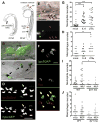Neutrophils exert protection in the early tuberculous granuloma by oxidative killing of mycobacteria phagocytosed from infected macrophages
- PMID: 22980327
- PMCID: PMC3638950
- DOI: 10.1016/j.chom.2012.07.009
Neutrophils exert protection in the early tuberculous granuloma by oxidative killing of mycobacteria phagocytosed from infected macrophages
Abstract
Neutrophils are typically the first responders in host defense against invading pathogens, which they destroy by both oxidative and nonoxidative mechanisms. However, despite a longstanding recognition of neutrophil presence at disease sites in tuberculosis, their role in defense against mycobacteria is unclear. Here we exploit the genetic tractability and optical transparency of zebrafish to monitor neutrophil behavior and its consequences during infection with Mycobacterium marinum, a natural fish pathogen. In contrast to macrophages, neutrophils do not interact with mycobacteria at initial infection sites. Neutrophils are subsequently recruited to the nascent granuloma in response to signals from dying infected macrophages within the granuloma, which they phagocytose. Some neutrophils then rapidly kill the internalized mycobacteria through NADPH oxidase-dependent mechanisms. Our results provide a mechanistic link to the observed patterns of neutrophils in human tuberculous granulomas and the susceptibility of humans with chronic granulomatous disease to mycobacterial infection.
Copyright © 2012 Elsevier Inc. All rights reserved.
Figures







Comment in
-
"With a little help from my friends": efferocytosis as an antimicrobial mechanism.Cell Host Microbe. 2012 Sep 13;12(3):261-3. doi: 10.1016/j.chom.2012.08.008. Cell Host Microbe. 2012. PMID: 22980322 Free PMC article.
-
Host response: double trouble for TB.Nat Rev Microbiol. 2012 Nov;10(11):730. doi: 10.1038/nrmicro2908. Nat Rev Microbiol. 2012. PMID: 23070551 No abstract available.
Similar articles
-
The role of the granuloma in expansion and dissemination of early tuberculous infection.Cell. 2009 Jan 9;136(1):37-49. doi: 10.1016/j.cell.2008.11.014. Cell. 2009. PMID: 19135887 Free PMC article.
-
Real-time visualization of mycobacterium-macrophage interactions leading to initiation of granuloma formation in zebrafish embryos.Immunity. 2002 Dec;17(6):693-702. doi: 10.1016/s1074-7613(02)00475-2. Immunity. 2002. PMID: 12479816
-
Infection and RNA-seq analysis of a zebrafish tlr2 mutant shows a broad function of this toll-like receptor in transcriptional and metabolic control and defense to Mycobacterium marinum infection.BMC Genomics. 2019 Nov 20;20(1):878. doi: 10.1186/s12864-019-6265-1. BMC Genomics. 2019. PMID: 31747871 Free PMC article.
-
Looking within the zebrafish to understand the tuberculous granuloma.Adv Exp Med Biol. 2013;783:251-66. doi: 10.1007/978-1-4614-6111-1_13. Adv Exp Med Biol. 2013. PMID: 23468113 Review.
-
New models for the study of Mycobacterium-host interactions.Curr Opin Immunol. 2004 Aug;16(4):499-505. doi: 10.1016/j.coi.2004.05.011. Curr Opin Immunol. 2004. PMID: 15245746 Review.
Cited by
-
Early secreted antigenic target of 6 kDa (ESAT-6) protein of Mycobacterium tuberculosis induces interleukin-8 (IL-8) expression in lung epithelial cells via protein kinase signaling and reactive oxygen species.J Biol Chem. 2013 Aug 30;288(35):25500-25511. doi: 10.1074/jbc.M112.448217. Epub 2013 Jul 18. J Biol Chem. 2013. PMID: 23867456 Free PMC article.
-
Efferocytosis of Apoptotic Neutrophils Enhances Control of Mycobacterium tuberculosis in HIV-Coinfected Macrophages in a Myeloperoxidase-Dependent Manner.J Innate Immun. 2020;12(3):235-247. doi: 10.1159/000500861. Epub 2019 Jun 27. J Innate Immun. 2020. PMID: 31247619 Free PMC article.
-
Immunity to the Dual Threat of Silica Exposure and Mycobacterium tuberculosis.Front Immunol. 2019 Jan 9;9:3069. doi: 10.3389/fimmu.2018.03069. eCollection 2018. Front Immunol. 2019. PMID: 30687311 Free PMC article. Review.
-
In search of a new paradigm for protective immunity to TB.Nat Rev Microbiol. 2014 Apr;12(4):289-99. doi: 10.1038/nrmicro3230. Epub 2014 Mar 3. Nat Rev Microbiol. 2014. PMID: 24590243 Free PMC article. Review.
-
NADPH oxidase-driven phagocyte recruitment controls Candida albicans filamentous growth and prevents mortality.PLoS Pathog. 2013;9(10):e1003634. doi: 10.1371/journal.ppat.1003634. Epub 2013 Oct 3. PLoS Pathog. 2013. PMID: 24098114 Free PMC article.
References
-
- Abadie V, Badell E, Douillard P, Ensergueix D, Leenen PJ, Tanguy M, Fiette L, Saeland S, Gicquel B, Winter N. Neutrophils rapidly migrate via lymphatics after Mycobacterium bovis BCG intradermal vaccination and shuttle live bacilli to the draining lymph nodes. Blood. 2005;106:1843–1850. - PubMed
-
- Amulic B, Cazalet C, Hayes GL, Metzler KD, Zychlinsky A. Neutrophil function: from mechanisms to disease. Annu Rev Immunol. 2012;30:459–489. - PubMed
Publication types
MeSH terms
Substances
Associated data
- Actions
- Actions
Grants and funding
LinkOut - more resources
Full Text Sources
Other Literature Sources
Molecular Biology Databases

